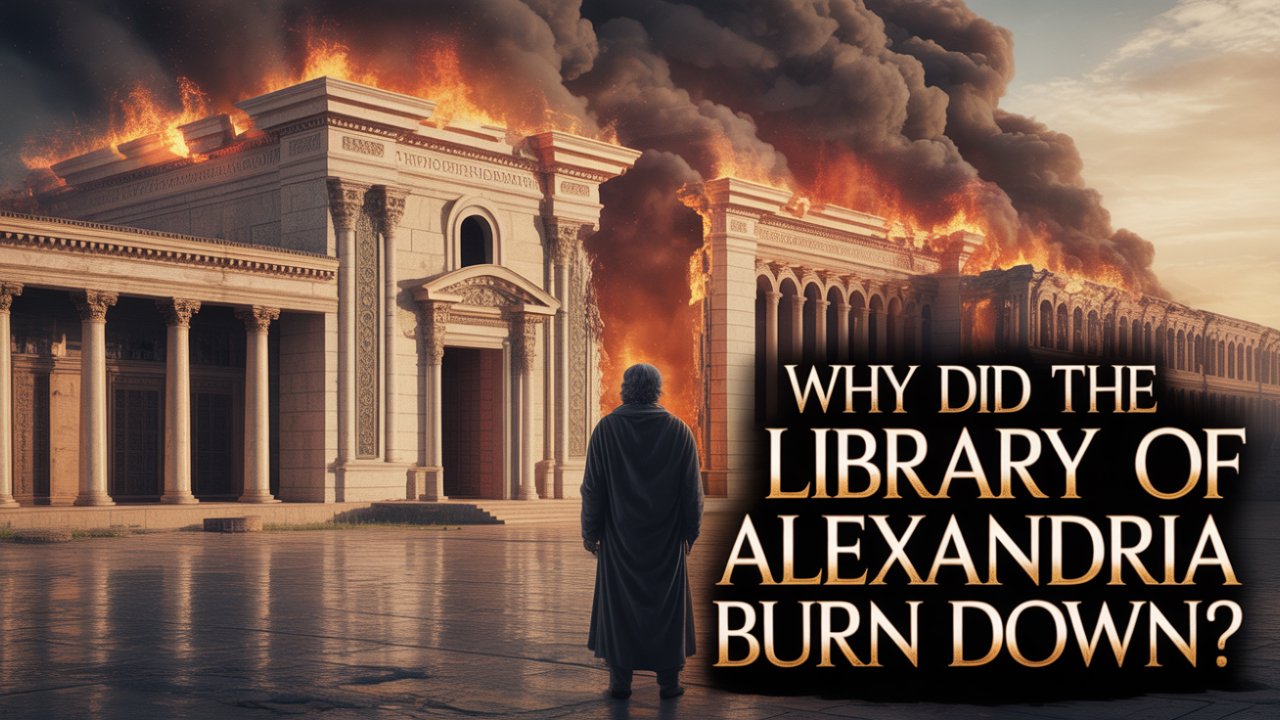For centuries, a single, incandescent image has dominated our collective memory of the Library of Alexandria: a catastrophic fire, a civilizational cataclysm that plunged humanity into an intellectual dark age. We picture columns of flame devouring marble, the accumulated wisdom of generations crackling into ash. It is a powerful, exquisitely cinematic tragedy the notion that a lone event set humanity back a millennium, that our intellectual inheritance was impoverished in a single, brutal night.
But what if that story, in its elegant simplicity, is a fabrication?
What if the Library’s true demise is a far more intricate, and therefore more harrowing, narrative? A death not by a singular, explosive inferno, but by a thousand cuts a protracted attrition inflicted over centuries. A slow, agonizing decay born of political rot, ideological fanaticism, and the brutal, shifting realities of a world in flux. This isn’t the story of one calamitous act of destruction. It is the story of how an idea the most audacious intellectual project in human history was systematically allowed to wither and perish. Confronting that truth is infinitely more vital, and more terrifying, than the myth.
Today, we journey back to the heart of the ancient world, to a city conceived in the dreams of a conqueror, and to an institution that sought nothing less than to contain the totality of human knowledge. We will walk its imagined halls, encounter the brilliant minds who gave it purpose, and confront the enduring, complex mystery of its obliteration. This is the story of the Library of Alexandria, and its truly unfathomable loss.
To comprehend the Library, one must first appreciate the city that served as its crucible. Alexandria was no ordinary metropolis. Founded by Alexander the Great around 331 BCE, it was engineered from its very foundations to be the nexus of the known world. Poised on the Mediterranean coast of Egypt, it became a vibrant melting pot where the intellectual traditions of Greece met the profound antiquity of Egypt, and where merchants from across civilization traded not just goods, but ideologies and narratives. It was a city of breathtakingly wide avenues, magnificent temples, and the towering Pharos lighthouse one of the Seven Wonders of the Ancient World.
It was in this dynamic, cosmopolitan environment that Alexander’s successor in Egypt, Ptolemy I Soter a man who was not only Alexander’s trusted general but also a historian in his own right initiated a plan of breathtaking ambition. Possibly on the counsel of the exiled Athenian statesman Demetrius of Phalerum, Ptolemy envisioned an institution that would elevate Alexandria beyond mere commercial wealth, transforming it into the undisputed intellectual capital of the globe. He named it the Mouseion, or “Shrine of the Muses,” a sprawling research institution inspired by Aristotle’s Lyceum in Athens. It would be a sanctuary for the arts and sciences, replete with lecture halls, botanical gardens, and residences for scholars. At its core, its ever-beating heart, would be the Library.
The vision was as simple as it was audacious: to collect all the knowledge of the world under one roof. It was a concerted, state-funded attempt to forge a universal library, a singular repository for every scroll ever written, on every conceivable subject, from every known culture. The Ptolemaic kings who succeeded him poured colossal resources into this quest. Agents were dispatched across the Mediterranean and beyond, with standing orders to acquire texts from Greece, Persia, and India anywhere knowledge was recorded.
Their acquisition methods were simultaneously systematic, aggressive, and arguably ruthless, yet stunningly effective. In one infamous policy, every ship docking in Alexandria’s bustling harbor was systematically searched for books. Any scrolls discovered were confiscated and transported to the Library for meticulous transcription. The original scroll was absorbed into the Library’s collection, while the owner received a copy in return. In another instance, Ptolemy III formally requested to borrow Athens’s precious, state-owned original manuscripts of the great tragedians: Aeschylus, Sophocles, and Euripides. The Athenians, justifiably wary, demanded an enormous sum of silver as collateral. Ptolemy III paid the deposit, had the scrolls copied onto the finest quality papyrus, and then sent the pristine copies back to Athens, forfeiting the silver to keep the priceless originals.
Through such tactics, the collection expanded at a staggering rate. While definitive numbers are lost to history, estimates place the Library’s holdings at its zenith between 40,000 and 400,000 papyrus scrolls. Even the most conservative of these figures is astounding for a pre-printing age, where every word was a product of intensive manual labor. The volume of material became so immense that a “daughter library” was established at the nearby temple of Serapis, the Serapeum, simply to manage the overflow.
No physical remains of the Great Library have ever been definitively identified, leaving us to reconstruct it from historical descriptions. It was an integral part of the Mouseion, situated in the royal quarter near the palace and the harbor. Imagine sprawling colonnaded halls, airy reading rooms, and vast stacks where the accumulated wisdom of humanity was cataloged, stored, and debated. It was more than a library; it was the world’s first government-funded, large-scale research institute.
The true genius of the Library was not the papyrus, but the people. The Ptolemies grasped a profound truth: a collection of books is merely a warehouse. It is the prepared human mind that transforms ink on a scroll into discovery and innovation. They established the ancient world’s most prestigious think tank, offering scholars generous salaries, free lodging, and exemptions from taxes the earliest known system of institutional research grants. This magnetic pull attracted the greatest intellects of the Hellenistic world, turning Alexandria into a crucible of intellectual ferment.
Imagine the intellectual energy crackling in those halls. To manage the deluge of information they were gathering, the scholars required a revolutionary conceptual tool.
Enter Callimachus of Cyrene. A poet and formidable scholar, he undertook a monumental task that would define the very nature of libraries for millennia. Faced with an overwhelming influx of scrolls, Callimachus conceived and executed the Pinakes, or “Tables.” This was no mere inventory; it was arguably the first great work of epistemology, a Herculean effort to impose a rational structure upon the totality of human expression. In 120 meticulously organized volumes, he classified the entire collection by subject and author, subdividing human knowledge into categories like poetry, history, and medicine, and listing authors alphabetically with brief, critical biographies. In an age drowning in a new sea of information, Callimachus created the system to navigate it. He was the architect of knowledge organization.
With the world’s knowledge methodically organized at their fingertips, the scholars of the Mouseion began to construct new worlds of understanding upon it. The head librarian Eratosthenes, a true polymath, conducted one of history’s most brilliant experiments within this very ecosystem. He had read that in the southern city of Syene, the midday sun on the summer solstice cast no shadow in a deep well. Yet, on the exact same day in Alexandria, a vertical obelisk did cast a measurable shadow. By measuring the angle of that shadow and knowing the distance between the two cities, he employed simple geometry to calculate the circumference of the Earth. His calculation was astonishingly precise approximately 24,650 miles, a mere fraction off the 24,900 miles we know today. Two millennia before satellites, a man with a stick, a well, and the power of institutionalized reason measured the planet.
The breakthroughs were relentless. Euclid codified the eternal rules of geometry in his Elements, a work so foundational it remained a standard textbook into the 20th century. Hero of Alexandria, a visionary engineer, constructed the first known steam engine, the aeolipile. The astronomer Aristarchus of Samos proposed a heliocentric model of the solar system, placing the Sun at its center nearly 1,800 years before Copernicus. His original work is tragically lost, known to us only because other intellectual giants, like Archimedes, cited it.
These were not isolated prodigies; they were a community. They collaborated to translate, edit, and standardize the great works of the past, producing the definitive editions of Homer’s Iliad and Odyssey and translating the Hebrew Bible into Greek the Septuagint. The Library was a living, breathing organism of thought, a place where knowledge was not merely warehoused, but synthesized, challenged, and born anew. This golden age, however, was tragically finite.
If you find this deep dive into the complexities of history compelling, ensure you subscribe and activate notifications. It’s the best way to support more content that explores the greatest stories and mysteries of our collective past.
The most enduring story about the Library’s demise is also the most theatrical. The year is 48 BCE. The villain, Julius Caesar.
As the legend holds, Caesar was mired in an Egyptian civil war, backing Cleopatra in her dynastic struggle against her brother. Cornered in Alexandria, he commanded his soldiers to set fire to his enemy’s ships in the harbor to repel an attack. The blaze, fanned by coastal winds, spiraled out of control, leaping from the ships to the docks and then into the city proper. In this conflagration, the Great Library the sanctum of ancient wisdom was allegedly consumed. Ancient writers like Seneca and Plutarch wrote of 40,000 or even 400,000 scrolls being incinerated. For centuries, this was canon: the definitive end of the Library in a single, tragic accident.
For most modern historians, however, this is where the narrative unravels. While no one disputes that Caesar started a fire in the harbor, the claim that it annihilated the Great Library itself rests on shaky and contradictory ground. First, consider the geography. The main Library was an integral part of the Mouseion complex, situated within the stone-built royal quarter, a significant distance from the docks. While a fire spreading is plausible, its capacity to consume a massive, well-constructed complex further inland is questionable.
Even more damning is the silence from those who would have spoken loudest. Caesar himself, in his detailed account of the civil war, mentions setting fire to the ships but never claims the destruction of the Library. His numerous political enemies in Rome, who would have seized any opportunity to depict him as a barbarian, never leveled the accusation. Critically, the geographer Strabo, visiting Alexandria just two decades after the event, described his visit to the Mouseion as a functioning institution, with no mention of it having been recently destroyed and lamenting only that its resources were not what they once were.
So, what actually burned? The most credible explanation is that the fire destroyed warehouses near the harbor that were filled with scrolls perhaps volumes crated for export or new acquisitions awaiting cataloging. The loss of 40,000 scrolls would still have been a devastating intellectual blow, a deep wound to the body of knowledge, but it was not the death of the institution itself.
Caesar’s fire, therefore, wasn’t the mortal wound. It was, however, the first deep cut a tangible, damaging event and a grim harbinger of the chronic instability that would come to define the Library’s fate. The myth of a single, accidental fire obscures a more protracted and arguably more painful truth: the Library didn’t just burn; it was permitted to fade away.
A single, great fire offers a simple, dramatic narrative with a clear villain. The reality of a long, slow decay is far more dispiriting and complex. The Library of Alexandria did not die in a blaze of glory. It withered on the vine, starved of the very elements that had allowed it to flourish: stable patronage, intellectual freedom, and robust financial support.
The pathology originated not from an external shock, but from an internal decay a political rot that began within the Ptolemaic dynasty itself. While the early Ptolemies were enlightened patrons, their successors were often consumed by brutal internal power struggles. The decline began in earnest under Ptolemy VIII Physcon in the mid-2nd century BCE. Following a vicious civil war, Physcon turned on the city’s intellectual elite. In 145 BCE, he expelled all foreign scholars from Alexandria, triggering a catastrophic brain drain. The head librarian, Aristarchus of Samothrace, and other brilliant minds were forced to scatter across the Mediterranean, taking their invaluable expertise with them. The vibrant, synergistic community that had made the Library a crucible of innovation was shattered.
As the political and economic power of the Ptolemies waned, so too did their capacity and desire to fund the Library’s immense operational needs. Papyrus is a fragile medium; a scroll might only survive for a century or two before it requires the laborious, expensive process of being re-copied by hand. Without a consistent and massive flow of royal funding to pay for this essential labor, the collection would have begun to literally crumble into dust.
The arrival of the Romans solidified its decline. After the death of Cleopatra in 30 BCE, Egypt was absorbed as a Roman province. For the new Roman masters, Alexandria’s primary value was as a breadbasket for the empire. The lavish, specific patronage that had been the Library’s lifeblood ceased. The intellectual center of gravity had decisively shifted to Rome, and Alexandria began its long, slow slide from being the center of the world to a provincial capital.
The city itself suffered grievously from the empire’s instability. During the chaotic “Crisis of the Third Century,” the Roman Emperor Aurelian laid siege to Alexandria in the 270s CE. His forces destroyed a significant portion of the Bruchion district the old royal quarter where the Mouseion and the Great Library were located. It is highly probable that whatever remained of the main Library was destroyed or irreparably damaged in this conflict. This was not a targeted assault on knowledge, but the brutal, indifferent collateral damage of war.
The great institution was dying. It was being starved, neglected, and battered by the unforgiving tides of politics. The dramatic fire of Caesar’s era was a potent myth. This slow, agonizing death by a thousand cuts was the grim reality. The final blows would not be struck against the Library itself, which was likely already a ghost, but against the very idea of pagan knowledge it had once represented.
By the late 4th century CE, the Great Library of the Mouseion was almost certainly a memory. The Roman Empire was now officially Christian, and the old pagan traditions were under systematic attack. It is here we encounter the final two chapters in the Library’s story chapters clouded by a mixture of fact, myth, and propaganda.
The first event is historically certain. It concerns the “daughter library” housed within the Serapeum, a magnificent temple dedicated to the Greco-Egyptian god Serapis, which held a significant collection of scrolls. In 391 CE, the fiercely anti-pagan Bishop of Alexandria, Theophilus, spurred by an imperial decree from Emperor Theodosius I to close pagan sites, led a mob of Christian zealots to the temple. They stormed the compound, smashing religious statues, hacking the colossal figure of Serapis to pieces, and carving crosses into the temple’s defiled walls.
The destruction of the Serapeum was a catastrophic act of ideological violence. But was it the final destruction of the Great Library? No. While the Serapeum did house an important library, it was the “daughter,” not the main institution that was likely already gone. Tellingly, contemporary accounts of the attack focus on the smashing of idols and the desecration of the temple; none mention the deliberate, large-scale burning of a library of scrolls.
This era also saw the tragic murder of Hypatia in 415 CE, a brilliant female Neoplatonist philosopher and mathematician, by a Christian mob. While her death is often invoked as a symbol of the death of classical learning, and she was a respected teacher in Alexandria, she had no direct connection to the by-then defunct institution of the Library.
The final, and most demonstrably false, story surfaces centuries later, placing the blame on the Arab conquest of Alexandria in 642 CE. According to this tale, the victorious Caliph Umar declared that if the library’s books conformed to the Quran, they were redundant; if they contradicted it, they were heretical. The scrolls were then supposedly distributed as fuel for the city’s bathhouses, lasting for six months. It’s a vivid story that has been deployed for centuries as propaganda. But it is a complete fabrication. The story first appears in the writings of a Syrian Christian bishop over 600 years after the event. No contemporary sources including Christian chronicles hostile to the Arab conquest ever mention it. Given that the Great Library and even the Serapeum library were long gone by 642 CE, the story is a historical impossibility.
The story of the Library of Alexandria we’ve all been told is simple and seductive: a single, terrible fire. It presents a neat, contained tragedy. It allows us to indulge in the fantasy of a world where, if not for one accident, we might possess all the lost knowledge of antiquity.
But the real history is far messier, more complex, and ultimately more unsettling. The Library of Alexandria was not destroyed in a day. It was allowed to die. Its end was a long, slow process of a thousand cuts. It was bled dry by political instability, starved of funding, and battered by the collateral damage of war. Its collection was physically eroded by time itself, as fragile scrolls crumbled without the resources or will to preserve them. It was finally rendered obsolete by a new world order with new priorities and new orthodoxies.
The loss is no less profound for being gradual. The thousands of lost works of literature, science, and history are still gone. We can only speculate about the masterpieces of Sophocles we have never read or the scientific treatises that might have answered countless questions about the ancient world. The loss is unfathomable not because of a single fire, but because a civilization, over the course of centuries, lost the will to maintain its own collective memory.
This is the true, tragic lesson of Alexandria. Knowledge is not a stone monument, impervious to time; it is a living garden that requires constant, dedicated tending. It can be lost not just to the flame of fanaticism, but to something far more common and insidious: apathy and neglect.
And yet, the idea of Alexandria never truly died. Today, not far from where the ancient institution once stood, rises the Bibliotheca Alexandrina, a stunning modern library that opened in 2002. Its magnificent granite walls are carved with characters from every known alphabet, a testament to that original universal dream. It is not the ancient library reborn, but it is a powerful, defiant statement that the human quest to gather, preserve, and share knowledge the enduring spirit of Alexandria is as vital today as it ever was.
What do you believe is the greatest intellectual or cultural loss from the ancient world? Share your thoughts in the comments below. And for more journeys into the intricate stories of our past, don’t forget to subscribe. Thank you for watching.





